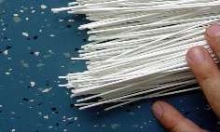Dual-Stage System produces reusable water from wastewater.
Share:
Press Release Summary:

Membrane Bio Reactor combines diffused aeration and biological treatment with membrane filtration to produce reusable water in 8 hr. After air is added to incoming effluent, bacteria reduce organic content. Stage 2 filters water through membranes resembling rows of straws with microscopic pores that draw clear liquid into them while keeping solids out. System can be operated automatically from computer, without any human interfaces.
Original Press Release:
Innovative Technology to Produce High-quality Reusable Water From Wastewater
From concept to initial sale, ITT Industries' Sanitaire launched an entirely new technology for treating wastewater in only 18 months. Municipal and industrial customers, especially in water-scarce regions, wanted a more efficient system for cleaning wastewater to use for irrigation or process water, or to discharge into streams with zero harm to the ecosystem.
Sanitaire delivered a technologically advanced process called MBR (Membrane Bio Reactor), a two-stage system combining diffused aeration and biological treatment with membrane filtration for high-quality reusable water.
"This technology solves a lot of problems for industry," says Michael Dimitriou, director of the MBR project. "High-quality reusable water addresses water scarcity issues. Customers can meet even the most stringent new regulations for wastewater."
Wastewater into Clean Water
The first stage treats the wastewater biologically. After air is added to the incoming effluent, bacteria reduce the organic content. Stage two filters the water through membranes resembling rows of small straws with microscopic pores that draw the clear liquid into them while keeping solids out. "You end up with water that's almost crystal clear, devoid of bacteria, viruses and other pathogens," explains Dimitriou.
While MBR's have been around awhile, Sanitaire pushed the technology forward with the dual-stage approach.
Other MBR systems merely insert a filtration membrane into a biological reactor, optimizing the filtration step.
With the dual-stage MBR, however, the filtration and biological steps are both optimized by physically separating them in the same tank.
Totally Automatic
MBR offers a host of advantages over alternative systems. It delivers a consistently high-quality effluent, produces less sludge, reduces energy and cleaning costs, and takes eight hours to fully treat wastewater versus 24 hours with conventional methods.
It's also a simpler process to operate. "It can be operated automatically, strictly off a computer, without any human interfaces for decision making," explains Dimitriou. MBR takes up less space, too. It would require five times more area and multiple process steps for a standard system to do the same amount of work.
A Growth Market
The new technology follows Sanitaire's business plan to aggressively pursue the fastest-growing segment of the wastewater treatment business. While the conventional wastewater treatment market is growing 4-6 percent a year, the market for advanced treatment methods is expanding 12 percent or more. And Dimitriou estimates the average order for an MBR will be a hefty $1 million to $1.5 million. Since Sanitaire already has the biological treatment expertise that advanced systems require, "it's a good strategic fit to go after this market vigorously," notes Dimitriou.
Vigorously is the word. Only a month after MBR was available, the first big order came in - from Sandpiper Development Company, a housing and development business in North Carolina. Sandpiper was using a conventional filtering system that took up too much space and did not produce the quality of water needed for irrigation. The MBR they purchased can deliver 200,000 gallons of clean - very clean - water daily.
VBPD = MBR
MBR was Sanitaire's first use of the Value-Based Product Development (VBPD) methodology. A 30-person team from all parts of the value center - Sanitaire U.S, Sanitaire U.K and the PCI division - worked cohesively and formed partnerships with key suppliers such as Puron, a German manufacturer of filtration membranes.
As part of the process, Sanitaire made extensive use of the "voice of the customer," by surveying customers at each stage of development to ensure the final product met their needs. "VBPD was a brand new approach to developing a new technology by Sanitaire, and it worked brilliantly," says Dimitriou.water.




